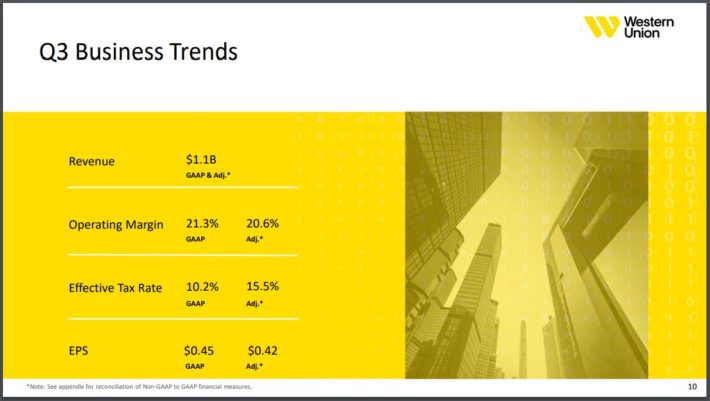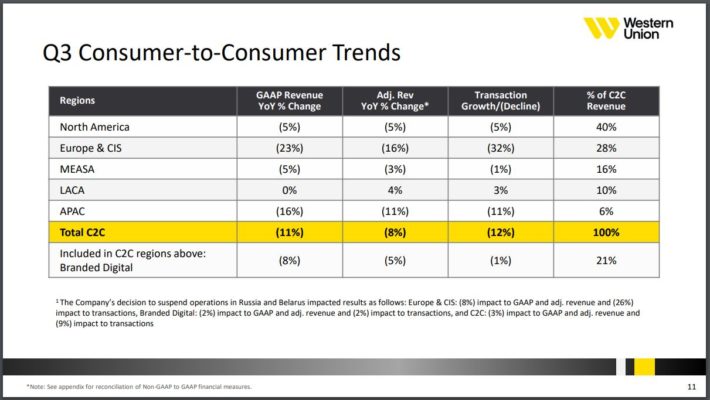Updated on January 17th, 2023 by Nathan Parsh
High yield stocks with dividend yields above 5% are appealing for income investors. However, not all high dividend stocks are created equal. Some have secure dividend payouts. And others are in questionable financial condition, leaving shareholders vulnerable to a dividend cut in a downturn.
With this in mind, we created a full list of high dividend stocks.
You can download your free full list of all high dividend stocks with 5%+ yields (along with important financial metrics such as dividend yield and payout ratio) by clicking on the link below:
Western Union (WU) has been a high dividend yield stock for several years. The company has struggled with growth in a mature business, but it is profitable. Management has increasingly returned cash to shareholders, and the yield is now approaching 7%, supported by a reasonably conservative payout ratio. Despite rising competition, the dividend yield is safe in the near term.
Business Overview
The Western Union Company is the world leader in domestic and international money transfers. The company operates in three segments Consumer-to-Consumer (C2C), Business Solutions, and Other. The company was founded in 1851.
The C2C business consists of money transfers between consumers using the firm’s global network of agents, the website, and the app. Western Union has nearly 600,000 third-party agents globally and operates in more than 200 countries. In addition, the app and website allow digital money transfers between consumers. The company serves about 150 million consumers.
The Business Solutions segment allows payments and cross-border payments for businesses. The Other segment is mainly bill payments in the US and Argentina and money orders. In addition, the company sold the Speedpay (US bill payments) and Paymap (mortgage payments) businesses in 2019. The Business Solutions segment will be sold for $910 million, with closing expected in the first quarter 2023.
Total revenue was $5.1 billion in 2021 and $4.7 billion in the past 12 months.
Western Union reported results for the third quarter of fiscal year 2022 on November 1st, 2022.

Source: Investor Presentation
Revenue fell 15.3% to $1.09 billion while adjusted earnings-per-share of $0.45 compared unfavorably to $0.57 in the prior year. C2C revenue declined 11% to $982.4 million from $1.1 billion on a year-over-year basis due to lower transaction volumes. Digital Money Transfer C2C revenues decreased 8% and digital money transfer volume fell 1%. Cross border transaction fell 13%. Business Solutions revenue declined 63%to $42.6 million from $116.8 million.
Growth Prospects
Western Union’s main C2C business is mature but very profitable. In addition, the company is by far the leader in agent money transfers. It is several times larger based on revenue than the number two competitor. The company makes money by transferring money and taking a small fee it shares with agents. However, both volumes and revenue growth are flat-to-declining due to increasing competition from electronic money transfers and new players in that space.
Theoretically, adding agents and additional geographies should lead to incremental growth. Therefore, the company actively adds partners to build its network and maintain its scale. For instance, Western Union is partnered with Walmart. However, with nearly 600,000 agents and operations in 200 countries, there is probably little in the way of future growth in the traditional C2C business.
On the other hand, digital money transfer operations are increasing. The company focused on this business a few years ago and now has an app and the WU dot.com website. As a result, digital money transfer volumes and revenue are growing. In addition, the COVID-19 pandemic boosted volumes and revenue as consumers transitioned from retail to digital channels.
As a result, approximately 21% of C2C revenue is through the digital money transfer channel. However, solid growth in this arena has not translated into an overall increase in the C2C business.

Source: Investor Relations
The main challenge for growth is stiff competition in digital money transfers. The company faces competition from well-funded and larger competitors. Companies such as Xoom, Square, Zelle, Stripe, and many others offer digital money transfers domestically. Increasingly, they are offering the same service internationally.
Competitive Advantages
Western Union has several competitive advantages. First, the name and brand are well-known worldwide for money transfers. Second, the company is the market leader. Third, the company probably has the highest name recognition in the money transfer business.
Next, Western Union is the most significant player in the C2C money transfer business. This fact confers an advantage in operating and cost efficiencies. The extensive network means adding additional agents or consumers only results in incremental cost increases. As a result, Western Union’s operating margins of roughly 22% are higher than its main competitor.
Lastly, Western Union’s business model calls for the use of third-party agents. This point means costs are low, and little capital is needed for investment. Furthermore, the extensive network and broad geographic presence mean the company can offer money transfers almost anywhere. In less developed countries, having an extensive agent network is a significant advantage since an agent is needed to send money and receive money.
Dividend Analysis
Western Union pays a healthy dividend yield. And up until recently, the company has delivered an increasing dividend for seven years, making the stock a Dividend Challenger.
However, Western Union has now distributed the same $0.235 each quarter for the last two years.
Still, the yield is very attractive on the stock. The forward dividend rate is $0.94 per share, giving an excellent forward dividend yield of about 6.7%. This value is greater than the 5-year average of 4.10%. It is also nearly four times the average dividend yield of the S&P 500 Index.
Although Western Union seemingly prioritizes share repurchases, it has continued to increase the dividend rate. The company’s dividend growth rate is around 9.1% in the past decade and approximately 5.5% for the trailing five-years.
The company’s dividend is safe from the perspective of earnings and free cash flow (FCF). The payout ratio is about 54% based on the forward dividend rate and estimated 2022 earnings per share of $1.80. In addition, Western Union generated FCF of approximately $1,007.6 million in 2021, and the dividend required only $381.6 million. Therefore, the dividend-to-FCF ratio is conservative at ~38%.
Western Union’s balance sheet is in a good position from the perspective of dividend safety. As of the most recent quarter, long-term debt was about $2.6 billion, offset by $1.18 billion in cash and equivalents. The leverage ratio is conservative at approximately 1.1X and the interest coverage is about 10.6X. The current credit rating is BBB / Baa2, a lower medium investment-grade credit rating by S&P Global and Moody’s.
Final Thoughts
High-yield stocks are appealing for investors seeking income. The problem is many have deteriorating businesses and weakening dividend safety metrics. Often, what was once an excellent dividend yield is no longer one because of a dividend cut or omission. However, Western Union’s dividend safety metrics are solid, and the yield is high.
Western Union is the market leader in consumer money transfers with its extensive agent network. The company is growing its digital money transfer business and should keep its scale and leadership.
Western Union is a good stock for investors seeking a high dividend yield and income.
If you are interested in finding more high-quality dividend growth stocks suitable for long-term investment, the following Sure Dividend databases will be useful:
The major domestic stock market indices are another solid resource for finding investment ideas. Sure Dividend compiles the following stock market databases and updates them regularly:
Thanks for reading this article. Please send any feedback, corrections, or questions to [email protected].
















